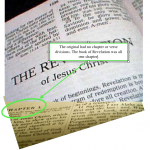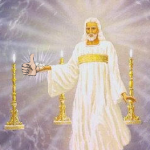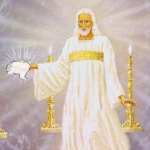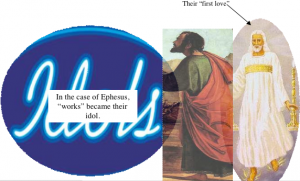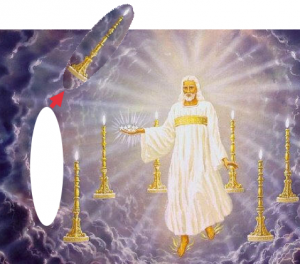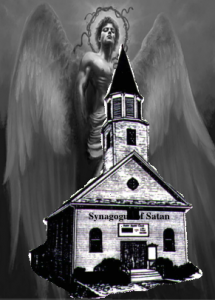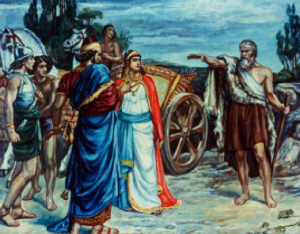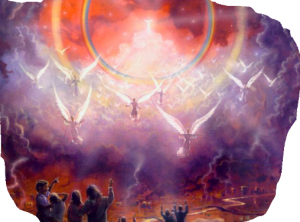It is important to understand that Revelation (unlike the book of Daniel which depicts visions that occurred at different periods of Daniel’s life), is arbitrarily divided into chapters. As far as John was concerned, it was really only one chapter from beginning to end with no breaks. This is Chapter “2” only because that is what the translators decided, not the apostle John.
Consequently, we need to keep in mind that the context of Chapter 2 is found in Chapter 1 where the “seven churches” are mentioned twice in Verses 11 and 20. What was said of them there, has application here. This is a principle which will stand us in good stead throughout the book of Revelation.
Verse 1: Unto the angel of the church of Ephesus write; These things saith he that holdeth the seven stars in his right hand, who walketh in the midst of the seven golden candlesticks;
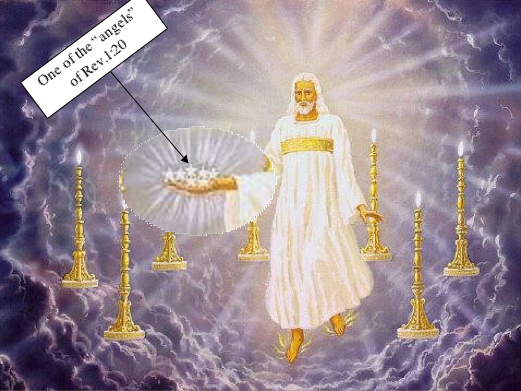
This “angel,” according to Revelation 1:20, is one of the “seven stars” held in the “right hand” of Jesus, the “Alpha and Omega, the beginning and the ending . . . the Almighty” (Revelation 1:8). In spite of being “held” in His “hand” the church was still required to choose between right and wrong. In other words, they were free to make wrong choices as well as correct ones. Note, even though this church resided in the “hand” of the “Almighty,” it still retained a serious defect that Jesus held to their account. If nothing else, this proves God to be a lover of freedom, which should inspire love in the hearts of those who are held “in his right hand.”
Note that Jesus always addresses the “angels” of the various churches [1] rather than the “churches” or “candlesticks” themselves, suggesting these messages are specifically for the church leaders who might better understand the symbolic language used, rather than the “laymen” whose understanding was less mature.
Even though that does not absolve the members of responsibility, it is often the case that the “people will seldom rise higher than their minister . . . The people make his deficiencies an excuse to cover their world-loving spirit.” [2] Therefore, these “. . . solemn messages that have been given in their order in the Revelation are to occupy the first place in the minds of God’s people [leaders and laity alike]. Nothing else is to be allowed to engross our attention.” [3]
Also, since these “messages extend to the end of time,” [4] they apply with equal force to all the Christian churches of our time. In fact: “ . . . the churches to which John was told to send the instruction given him represent all the churches in our world, and that this revelation to him is to be studied and believed and preached by the Seventh-day Adventist church today.” [5]
Verses 2 & 3: I know thy works, and thy labour, and thy patience, and how thou canst not bear them which are evil: and thou hast tried them which say they are apostles, and are not, and hast found them liars: And hast borne, and hast patience, and for my name’s sake hast laboured, and hast not fainted.
“Ephesus was the leading city of the Roman province of Asia . . . situated at the western terminus of a great highway that crossed Asia Minor from Syria . . .” The spiritual condition of the church of Ephesus, represented in these two verses and the following, is “characteristic of the whole church during the apostolic period, the era of Christian history reaching approximately to the end of the 1st century (c. A.D. 31-100).” [6]
Note, this is all judgment language. It is a critique of their character and behavior with Verses 2 and 3 itemizing things Christ heartily endorsed such as calling sin by its right name and being unafraid to stand up for truth in opposition to hypocritical “apostles” whose profession failed to measure up. Furthermore, they were untiring in their labors and did not “faint” from overwork.
That was the good news. Next, comes the bad:
Verse 4: Nevertheless I have somewhat against thee, because thou hast left thy first love.
Note the word “somewhat,” which tends to trivialize the strength of this message, is supplied. Therefore, this verse could read: “I am against thee, because thou hast left thy first love.” So, their “first love” was not a minor issue. In fact, it “was everything to them.” [7] Without the “first love” all the good depicted in Verses 2 and 3 was worthless.
They gained their “first love” at Pentecost. “And when the day of Pentecost was fully come, they were all with one accord in one place. And suddenly there came a sound from heaven as of a rushing mighty wind, and it filled all the house where they were sitting. And there appeared unto them cloven tongues like as of fire, and it sat upon each of them. And they were all filled with the Holy Ghost, and began to speak with other tongues, as the Spirit gave them utterance” (Acts 2:1-4).
Peter’s work exemplified the “first love.” “Then they that gladly received his word were baptized: and the same day there were added unto them about three thousand souls. And they continued stedfastly in the apostles’ doctrine and fellowship, and in breaking of bread, and in prayers. And fear came upon every soul: and many wonders and signs were done by the apostles. And all that believed were together, and had all things common; and sold their possessions and goods, and parted them to all men, as every man had need. And they, continuing daily with one accord in the temple, and breaking bread from house to house, did eat their meat with gladness and singleness of heart, praising God, and having favour with all the people. And the Lord added to the church daily such as should be saved” (Acts 2:41-47).
But, in spite of their tireless “works, labour, patience,” intolerance of “evil” and hypocrisy (see Verse 2), “. . . they lost their first love, they increased in a knowledge of scientific theories originated by the father of lies.” [8]
Verse 5: Remember therefore from whence thou art fallen, and repent, and do the first works; or else I will come unto thee quickly, and will remove thy candlestick out of his place, except thou repent.
Note the relationship of this message to the heavenly sanctuary, and its current application to our time, in this statement: “When this church is weighed in the balance of the sanctuary, it is found wanting, having left its first love . . . Is not this our case? Our doctrines may be correct; we may hate false doctrine, and may not receive those who are not true to principle; we may labor with untiring energy; but even this is not sufficient. What is our motive? . . . Let each member of the church study this important warning and reproof. Let each one see if in contending for the truth, if in debating on the theory, he has not lost the tender love of Christ. Has not Christ been left out of the sermons, and out of the heart? Is there not danger that many are going forward with a profession of the truth, doing missionary work, while the love of Christ has not been woven into the labor?
“This solemn warning from the True Witness means much; it demands that you shall remember from whence you are fallen, and repent, and do the first works . . . O that the church might realize its need of its first ardor of love! When this is wanting, all other excellences are insufficient. The call to repentance is one that cannot be disregarded without peril. A belief in the theory of the truth is not enough. To present this theory to unbelievers does not constitute you a witness for Christ. The light that gladdened your heart when you first understood the message for this time, is an essential element in your experience and labors, and this has been lost out of your heart and life. Christ beholds your lack of zeal, and declares that you have fallen, and are in a perilous position.” [9]
In view of this church’s critical failure, it seems odd some believe the symbol of the “white horse” that “went forth conquering, and to conquer” represents this “church in the apostolic age (c. A.D. 31-100).” [10] Certainly, from God’s point of view, it was headed for complete failure unless it repented. For the purpose of our study, we conclude that its candlestick was removed for it fails to meet Christ’s expectation.
Verse 6: But this thou hast, that thou hatest the deeds of the Nicolaitans, which I also hate.
Since no congregation labeled “the Nicolaitans” exists today, it might be tempting to conclude this feature has no bearing for our time. According to the Commentary, a sect known by this name disseminated the belief that “the deeds of the flesh do not affect the purity of the soul, and consequently have no bearing on salvation.” It was called Gnosticism, which was just a superficially intellectual way of making the sinner feel comfortable in his sin. [11]
We cannot, honestly, relegate it to the distant past. Even though White does not specify what their “deeds” were, [12] she does say “the doctrine is now largely taught that the Gospel of Christ has made the Law of God of no effect; that by ‘believing’ we are released from the necessity of being doers of the word. But this is the doctrine of the Nicolaitanes, which Christ so unsparingly condemned . . . Those who are teaching this doctrine to-day have much to say in regard to faith and the righteousness of Christ; but they pervert the truth, and make it serve the cause of error. They declare that we have only to believe on Jesus Christ, and that faith is all-sufficient; that the righteousness of Christ is to be the sinner’s credentials; that this imputed righteousness fulfils the law for us, and that we are under no obligation to obey the law of God. This class claim that Christ came to save sinners, and that he has saved them. ‘I am saved,’ they will repeat over and over again. But are they saved while transgressing the law of Jehovah? ―No; for the garments of Christ’s righteousness are not a cloak for iniquity: Such teaching is a gross deception, and Christ becomes to these persons a stumbling-block as he did to the Jews, ―to the Jews because they would not receive him as their personal Saviour; to these professed believers in Christ, because they separate Christ and the Law, and regard faith as a substitute for obedience. They separate the Father and the Son, the Saviour of the world. Virtually they teach, both by precept and example, that Christ, by his death, saves men in their transgressions.” [13] In other words, this is a “justification only” dogma with sanctification being irrelevant.
Do those features sound familiar? They should, because they are preached, even today, by those who adhere to what is known as the “new theology.” But, since it is almost 2,000 years old, it cannot really be called “new.”
Therefore, that was not a problem that only the church at Ephesus had to deal with. They hated the “deeds” of the self-deceived Nicolaitans just as much as Christ did. But, having lost their “first love,” their good deeds and self-sacrificing “labor” had degenerated into self-righteous legalism. Even though they saw the evil in the thinking of the Nicolaitans, the opposite extreme they fell into was no better.
Verse 7: He that hath an ear, let him hear what the Spirit saith unto the churches; To him that overcometh will I give to eat of the tree of life, which is in the midst of the paradise of God.
This first phrase, “he that hath an ear,” is repeated to each of the seven churches before their individual message is delivered.
The Ephesians had come to regard their good “works” as their ticket to heaven. But the Lord says here that such an attitude must be overcome, realizing that “our righteousnesses are as filthy rags” (Isaiah 64:6) that cannot save. Reliance on works, even if above reproach as were the Ephesian’s, takes us away from our Redeemer who offers us the “tree of life, which is in the midst of the paradise” in heaven. If we listen to the Spirit, He will give us renewed joy and love while performing service for the Master who “imputeth righteousness without works” (Romans 4:6).
Verse 8: And unto the angel of the church in Smyrna write; These things saith the first and the last, which was dead, and is alive;
He had just told John “Fear not: I am the first and the last: I am he that liveth, and was dead; and, behold I am alive for evermore, Amen” (Revelation 1:17, 18). It is crucial to believe this because “if Christ be not raised, your faith is vain; ye are yet in your sins . . . If in this life only we have hope in Christ, we are of all men most miserable” (1 Corinthians 15:17, 19). In other words, if Jesus never came out of the grave, our hope in His saving us is a pitiful waste of time!
Evidently the members of this congregation were facing a serious threat to life. Satan was trying to frighten them into making Jesus “last” in their lives, instead of “first,” in order to survive. Consequently, Jesus reassures them, even though He “was dead” He is now “alive,” and now He is “the first begotten of the dead” and has “the keys of hell and of death” (Revelation 1:5, 18).
John must have remembered Him saying something like that on their way back to Jerusalem just after resurrecting Lazarus: “he that loveth his life shall lose it; and he that hateth his life in this world shall keep it unto life eternal” (John 12:25).
Verse 9: I know thy works, and tribulation, and poverty, (but thou art rich) and I know the blasphemy of them which say they are Jews, and are not, but are the synagogue of Satan.
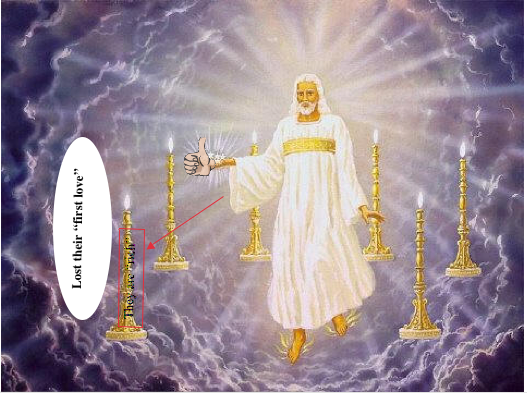
Note that Jesus scrutinizes the “works” of each of the seven churches, and says the least about Smyrna. [14] Judging from the context, He approved of their “works.” Then, in spite of the “tribulation, and poverty” they were experiencing, and, almost as an afterthought, He judged them “rich,” suggesting they met with His unqualified approval in spite of the “blasphemy” of the demonic “synagogue.”
According to the Commentary, “the Smyrna period of the church may be thought of as beginning about the close of the first century and continuing until about A.D. 313, when Constantine espoused the cause of the church.” [15] “Historically, the period represented by the Smyrna church may well be called the Age of Martyrdom.” [16]
“The history of the early church testified to the fulfillment of the Saviour’s words. The powers of earth and hell arrayed themselves against Christ in the person of his followers. Paganism foresaw that should the gospel triumph, her temples and altars would be swept away; therefore she summoned her forces to destroy Christianity. The fires of persecution were kindled. Christians were stripped of their possessions, and driven from their homes . . . Great numbers sealed their testimony with their blood. Noble and slave, rich and poor, learned and ignorant, were alike slain without mercy . . .
“These persecutions, beginning under Nero about the time of the martyrdom of Paul, continued with greater or less fury for centuries. Christians were falsely accused of the most dreadful crimes, and declared to be the cause of great calamities―famine, pestilence, and earthquake. As they became the objects of popular hatred and suspicion, informers stood ready, for the sake of gain, to betray the innocent. They were condemned as rebels against the empire, as foes of religion, and pests to society. Great numbers were thrown to wild beasts or burned alive in the amphitheaters. Some were crucified; others were covered with the skins of wild animals, and thrust into the arena to be torn by dogs. Their punishment was often made the chief entertainment at public fetes. Vast multitudes assembled to enjoy the sight, and greeted their dying agonies with laughter and applause.” [17]
What can we make of “the blasphemy of them which say they are Jews, and are not, but are the synagogue of Satan?” It seems they were professed members of the church. A “Jew,” in this case, should be thought of “in a figurative, not a literal, sense. As here used, the term no doubt refers to those who claimed to serve God, but actually served Satan . . . In the 2nd century Jews are said to have brought about the martyrdom of Polycarp, a bishop of Smyrna. During this time Tertullian speaks of the synagogues as ‘fountains of persecution.” [18]
The apostle Paul spoke of the difference between the true and the false Jew, saying: “For he is not a Jew, which is one outwardly . . . But he is a Jew, which is one inwardly . . . of the heart, in the spirit, and not in the letter; whose praise is not of men, but of God” (Romans 2:28, 29).
Note that the “church in Philadelphia” was also troubled by “the synagogue of Satan, which say they are Jews, and are not” (Revelation 3:9). Therefore “the synagogue of Satan” cannot be confined strictly to either the second or sixth periods of the Christian era, because these “messages extend to the end of time.” [19]
Consequently, the afflictions suffered by the Smyrnans will be repeated at the end of time when “. . . a large class who have professed faith in the third angel’s message, but have not been sanctified through obedience to the truth, abandon their position, and join the ranks of the opposition. By uniting with the world and partaking of its spirit, they have come to view matters in nearly the same light; and when the test is brought, they are prepared to choose the easy, popular side. Men of talent and pleasing address, who once rejoiced in the truth, employ their powers to deceive and mislead souls. They become the most bitter enemies of their former brethren. When Sabbath-keepers are brought before the courts to answer for their faith, these apostates are the most efficient agents of Satan to misrepresent and accuse them, and by false reports and insinuations to stir up the rulers against them.” [20]
Verse 10: Fear none of those things which thou shalt suffer: behold, the devil shall cast some of you into prison, that ye may be tried; and ye shall have tribulation ten days: be thou faithful unto death, and I will give thee a crown of life.
Apparently the “synagogue of Satan” enlisted the arm of civil authority which gave them the power to “cast some of” the Smyrnans into “prison,” and even the right to inflict capital punishment.
“For two centuries Christians were constantly subject to the possibility of sudden arrest and death for their faith. Their well-being depended in large measure upon the favor of their pagan and Jewish neighbors.” [21] Pagans, of course, do not profess to be “Jews” in any sense of the word and detest Christianity to the very core of their being, and during the historic period of the Smyrna church, for the most part, were the bitter enemies of Christians. We can assume this picture of Smyrna persecution is also intended to portray the situation that will exist in a future time of trouble for God’s people when the “synagogue of Satan” will have become successful in infiltrating church leadership.
But, if that is true, what about the ten day “tribulation”? Is that future also? While “the names of the seven churches are symbolic of the church in different periods of the Christian Era” their “messages [also] extend to the end of time . . .” [22] including, we must assume, the “ten day” period of “tribulation.”
The Commentary suggests “two ways” the “ten days” can be understood. The first, using the principle of prophetic day for a year time, it represents “a period of ten literal years and applied to the period of the most severe imperial persecution (A.D. 303-313), begun by Diocletian and continued by his associate and successor Galerius.” [23] Note “pagan Rome,” not the “synagogue of Satan” who profess to be “Jews,” were the persecutors. A “pagan,” especially during Roman times, would never allow themselves to be called either a “Jew” or a Christian. So, we should consider the second “way” the “ten days” could be understood.
The second way, according to the Commentary, is “for the ‘ten days’” to have a “literal application” which “would be entirely consistent with sound principles of prophetic interpretation . . . to the immediate historical situation at Smyrna, and a figurative application to the period of history represented by the Smyrna church.” [24] So, what would the “end of time message” be? [25]
Evidently, we can expect a repeat of a ten literal day period of unmitigated persecution against God’s people. It will last only ten days because, it seems, God “will finish the work, and cut it short in righteousness” (Romans 9:28) when He leaves the most holy place of the heavenly sanctuary.
“If the blood of Christ’s faithful witnesses were shed at this time, it would not, like the blood of the martyrs, be as seed sown to yield a harvest for God. Their fidelity would not be a testimony to convince others of the truth; for the obdurate heart has beaten back the waves of mercy until they return no more. If the righteous were now left to fall a prey to their enemies, it would be a triumph for the prince of darkness.” [26]
Verse 11: He that hath an ear, let him hear what the Spirit saith unto the churches; He that overcometh shall not be hurt of the second death.
While the end time significance of the church in Smyrna might be strenuously argued, the end time significance of the “second death” cannot be contested because it is defined in Revelation 20:6, 14 and 21:8. The “first death” carries with it the possibility of the “first resurrection,” while there is no possibility of a resurrection after the “second death.” That is why the “second death” will really “hurt.” The Smyrnan overcomers were obliged to choose between sparing themselves a premature “first death” by martyrdom or take the easy route which simply amounts to a postponement of the inevitable.
Christ didn’t take the easy route. He allowed Himself to be abused unmercifully and die a humiliating death on the cross. For the servant to be called upon to shed his blood like his Master is really a great honor. In fact, Peter, feeling “a sense of his cowardly denial of Christ throughout his lifetime . . . when called to suffer martyrdom for his faith . . . begged that he might not be crucified in the exact manner in which his Lord suffered, fearing that it would be too great an honor after his apostasy. His request was that he might be crucified with his head downward.” [27]
Verse 12: And to the angel of the church in Pergamos write; These things saith he which hath the sharp sword with two edges;
This “period of church history may be thought of as beginning about the time of Constantine’s espousal of the Christian cause, in A.D. 313 . . . and ending in 538. It was during this time that the papacy won religious, and to some extent political, leadership of Western Europe and that Satan established his ‘seat’ within the church. The papacy was a skillful blend of paganism with Christianity. This period may be termed the Age of Popularity.” [28] But, since “the messages [also] extend to the end of time,” [29] what Christ had to say to the “church in Pergamos” is of more than historic interest to us.
When John first “turned to see the voice that spake with him,” Jesus had “a sharp twoedged sword” coming “out of His mouth” (Revelation 1:12, 16; also 2:12) symbolizing the power of His word: “For the word of God is quick, and powerful, and sharper than any twoedged sword, piercing even to the dividing asunder of soul and spirit, and of the joints and marrow, and is a discerner of the thoughts and intents of the heart” (Hebrews 4:12, italics supplied). It cuts both ways, and penetrates, either to heal or destroy, with infinite precision. Evidently, Jesus had some sharp words for “the church in Pergamos.” But His words were not designed to destroy and wound needlessly, but to heal and bring restoration which could happen only if the church took His words seriously. Therefore, “sharp” words were necessary in order to get their attention.
Verse 13: I know thy works, and where thou dwellest, even where Satan’s seat is: and thou holdest fast my name, and hast not denied my faith, even in those days wherein Antipas was my faithful martyr, who was slain among you, where Satan dwelleth.
In spite of “the sharp sword” of Jesus’ mouth, these are words of commendation encouraging this church to continue holding “fast” to His “name” in spite of living in the adverse circumstances represented by “Satan’s seat.”
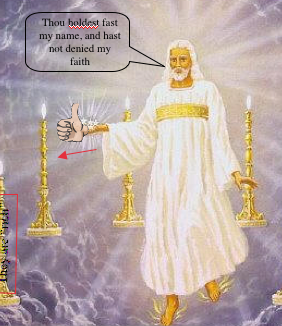
What is the relationship of “Satan’s seat” to the “synagogue of Satan” that afflicted the church in Smyrna?
The word “seat” is from the Greek word “thronos” [30] representing kingly power in heaven or earth. In this case it has to be “earth” because Satan has no authority in heaven. While the “synagogue of Satan” (Verse 9) represents Satan’s infiltration into the church, “Satan’s seat” must represent his authority as manifested in civil government where church and state are united. When church and state link up, the results are always evil and “Antipas,” a man Christ honored as His “faithful martyr,” was a good example of the evils of a system in which capital punishment is the unjust penalty for serving God.
A massive end-time outbreak of martyrdom is predicted in the end of the book of Revelation where John “saw the souls of them that were beheaded for the witness of Jesus, and for the word of God, and which had not worshipped the beast, neither his image, neither had received his mark upon their foreheads, or in their hands” (Revelation 20:4), a scenario yet to be seen when church and state come together to enforce “beast” and “image” worship, an area in which government has no God-given right to intervene.
Verse 14: But I have a few things against thee, because thou hast there them that hold the doctrine of Balaam, who taught Balac to cast a stumblingblock before the children of Israel, to eat things sacrificed unto idols, and to commit fornication.
This verse makes it clear Christ did not condemn this church for the unfavorable circumstances surrounding them, rather, it was their doctrines he disapproved of. It was just as fatal for them as for the Ephesian’s loss of their “first love.” While loss of their “first love” was a problem of attitude and motivation, a false doctrine, or a mistaken belief, is just as destructive of character and behavior. This verse pretty much spells it out. Eating “things sacrificed unto idols” and committing “fornication” characterize heathen behavior, completely at odds with Christian behavior.
Going back to the Old Testament, we find that Balaam” really did “cast a stumblingblock before the children of Israel,” enticing them into idol worship and “fornication” (Numbers 22-24). Although “Balac,” the king of Moab tried to bribe Balaam into cursing Israel, Balaam was unable to comply because God put words of blessing into his mouth instead of curses. Such was Balaam’s frustration, that, in order to secure the riches offered by Balac, he did something utterly perverse. He decided to play a trick on God! Knowing Israel’s weaknesses, he told Balac to send harlots into the midst of the encampment enticing the Israelites to commit fornication. He hoped that would be so offensive that God would be forced into cursing Israel. Then he could go back, laughing all the way home, loaded with gold! ―a case of deliberate, premeditated, spiritual treachery for the sake of gain. Even though “Balaam rose up, and went and returned to his place” (Numbers 24:25), the Israelites eventually caught up with him and “slew [him] with the sword.” (Numbers 31:8).
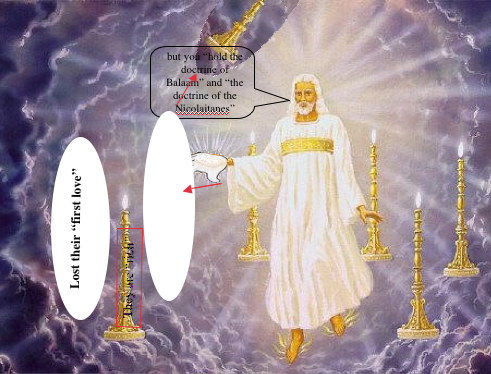
His character and that of Judas “bear a marked resemblance to each other. Both these men tried to unite the service of God and mammon, and met with signal failure. Balaam acknowledged the true God, and professed to serve Him; Judas believed in Jesus as the Messiah, and united with His followers. But Balaam hoped to make the service of Jehovah the stepping-stone to the acquirement of riches and worldly honor; and failing in this he stumbled, and fell, and was broken. Judas expected by his connection with Christ to secure wealth and promotion in that worldly kingdom which, as he believed, the Messiah was about to set up. The failure of his hopes drove him to apostasy and ruin. Both Balaam and Judas had received great light and enjoyed special privileges; but a single cherished sin poisoned the entire character, and caused their destruction.” [31]
“The same spirit which actuated Balaam, exists in the hearts of men today. How many claim to be Christians, while they are as destitute of true godliness as was the presumptuous prophet.” [32] Interestingly, Balaam taught Balac the same thing as “Jezebel, [who also taught] my servants to commit fornication and to eat things sacrificed unto idols (v. 20).
Verse 15: So hast thou also them that hold the doctrine of the Nicolaitans, which thing I hate.
We have already defined “the doctrine of the Nicolaitans” (Verse 6) as the teaching that faith negates the obligation to obey God’s law. While the Ephesians rejected that doctrine, the leaders of the church in Pergamos accepted it. Note, while Christ “hates” the doctrine, He was still seeking to save the “church in Pergamos” by warning them against what will destroy them.
Verse 16: Repent; or else I will come unto thee quickly, and will fight against them with the sword of my mouth.
Keep in mind, this threat is leveled specifically against the “the angel” or the leaders “of the church in Pergamos,” not those who had “not denied my faith” such as “Antipas . . . my faithful martyr . . .” (Verse 13). Nevertheless, Jesus, who did not condemn the Smyrnan church for the presence of the synagogue of Satan, still held it “against” (Verse 14) the church of Pergamos for retaining the leaders who taught the false doctrines of Balaam and the Nicolaitans. Evidently, the leaders of Smyrna were powerless to disfellowship the “synagogue of Satan,” while those of Pergamos could have cast out those false teachers.
Verse 17: He that hath an ear, let him hear what the Spirit saith unto the churches; To him that overcometh will I give to eat of the hidden manna, and will give him a white stone, and in the stone a new name written, which no man knoweth saving he that receiveth it.
The leaders in the church in Ephesus were responsible for overcoming the loss of their “first love,” the church in Smyrna for overcoming “fear” of “death” and “imprisonment.” The Pergamum leaders were faced with overcoming a point the Ephesian leaders were successful in overcoming, that of the “deeds of the Nicolaitans” (Verse 6) which they “hated.” Apparently, the Pergamum leaders saw light in the “doctrine” of Balaam, which, correspondingly, made the “doctrine of the Nicolaitans” acceptable.
To them, the cure, was found in the “doctrine of Balaam” (Verse. 14) suggesting the leaders of this church were low on funds, which they could increase by making their church more popular and thereby realize an increase in contributions. Thus “the Age of Popularity” (see on Verse 12), by which this period is known, has application because they traded truth for gold.
Therefore, the cure, is “the hidden manna,” a metaphor for the spiritual “manna” which could have saved the Pergamos leaders from committing spiritual treason. The value of the “hidden manna” far exceeds the material “manna” for which these leaders were more than willing to sacrifice truth for gain.
“The Lord has need of men who are spiritually sharp and clear-sighted, men who are certainly receiving manna fresh from heaven. The Holy Spirit works upon the hearts of such men, and God’s word flashes light into the mind, revealing to them more than ever before the true wisdom.” [33] “Deep, earnest study of the word under the guidance of the Holy Spirit will give you fresh manna, and the same Spirit will make its use effectual.” [33a] “The manna, falling from heaven for the sustenance of Israel, was a type of Him who came from God to give life to the world . . . And among the promises of blessing to God’s people in the future life it is written, ‘To him that overcometh will I give to eat of the hidden manna.’” [33b]
The “white stone” is very significant. “One of the more common ancient customs was that of the use of a white and a black stone by jurors to determine acquittal or conviction” [34], evidently with the “white” representing acquittal. Therefore, the “white stone” represents acquittal in the courts of heaven. But there is more to it, because ‘in the stone a new name [is] written” which represents Christ’s character, a supernatural substitution of His character for our own! WOW! This means we are not only justified but sanctified; enabled to live and be like Jesus! Interestingly, none will “know it” or really understand it except “he that receiveth” or accepts “it.” In other words, spirituality is nontransferable. “The soul is accountable to God alone.” [35]
Verse 18: And unto the angel of the church in Thyatira write; These things saith the Son of God, who hath his eyes like unto a flame of fire, and his feet are like fine brass;
In the introduction to the church of Ephesus, Jesus called attention to “the seven stars in his right hand” and His position “in the midst of the seven golden candlesticks.” For Smyrna, He referred to the fact He was “the first and the last” and was also once “dead,” but now “is alive.” For Pergamos, He referred to His “sharp sword with two edges” (Verses 1, 8, 12).
Now, for Thyatira, He refers to “his eyes . . . and his feet.” What is the point He is driving at with this symbolism? At the very least, it suggests each message is individually designed to address the specific needs of each of the church leaders. To Ephesus it was His tender care. To Smyrna He represented His power over death. To Pergamos the power and importance of His word, in contrast to false teachings. Here, to Thyatira, the symbolism must represent his omniscience and sense of justice.
Verse 19: I know thy works, and charity, and service, and faith, and thy patience, and thy works; and the last to be more than the first.
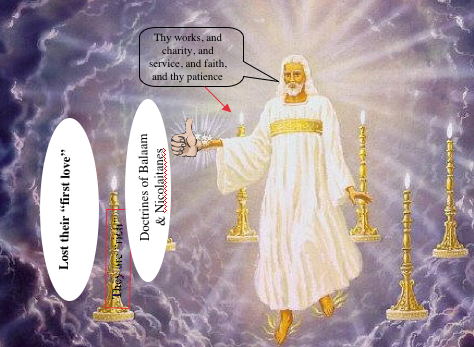
As applied to the history of the Christian church, Thyatira is generally recognized to cover “the experience of the true church in the Dark Ages” [36] between 538 and 1517 A.D.
Note the similarity of their “works, charity, service, faith, and patience” to the “labour” and “patience” demonstrated by the church of Ephesus, except that the last “works” of this church exceeded that of their “first” works, in contrast to the Ephesians who “left their first love” (Verse 4). This was the good news for the church in Thyatira. Unfortunately, some bad news was to follow, and we can learn much from it if we have eyes to see and ears to hear.
Verse 20: Notwithstanding I have a few things against thee, because thou sufferest that woman Jezebel, which calleth herself a prophetess, to teach and to seduce my servants to commit fornication, and to eat things sacrificed unto idols.
Notice the “few things” Jesus had against Thyatira in this verse, compared with “somewhat” that concerned the Lord about Ephesus (Verse 4), and the “few things” against Pergamos (Verse 14), suggesting that little things are important in God’s sight and that little things easily become great things if ignored.
Consider the Ephesians who “tried them which say they are apostles, and are not, and hast found them liars,” in contrast to the Thyatirans who “suffered” or allowed “that woman Jezebel,” who is probably one of the most outstanding liars of Biblical history. She taught that it is permissible to “eat things sacrificed unto idols, and to commit fornication,” the very same thing allowed by “the doctrine of Balaam” (Verse 14) in the case of Pergamos. Balaam “had been a prophet of God, and a good man; but he apostatized, and gave himself up to covetousness . . .” [37]
Jezebel also “sponsored the worship of Baal in Israel (1 Kings 21:25), so in John’s day some false prophetess was attempting to lead astray the church at Thyatira. The message indicates that here, even more than at Pergamum (Revelation 2:14), apostasy was openly and defiantly rampant. As applied to the Thyatira period of Christian history, the figure of Jezebel represents the power that produced the great apostacy of the medieval centuries.” [38] Nevertheless, her teachings, handed down through the centuries, had a profound influence on this church. Note that the church “suffer[ed] that woman,” or tolerated her. They were not like the Ephesians who were anything but tolerant.
Thyatira modeled the experience of the medieval church when “Paganism, while appearing to be vanquished, became the conqueror. Her spirit controlled the church. Her doctrines, ceremonies, and superstitions were incorporated into the faith and worship of the professed followers of Christ.” [39]
However, the problem cannot be relegated exclusively to medieval history any more than it can to the time of Jezebel. “Though in a different form, idolatry exists in the Christian world to-day as verily as it existed among ancient Israel in the days of Elijah. The god of many professedly wise men, of philosophers, poets, politicians, journalists, ―the god of polished fashionable circles, of many colleges and universities, even of some theological institutions, ―is little better than Baal, the sun-god of Phoenicia.” [40]
“The apostasy prevailing to-day is similar to that which in the prophet’s day overspread Israel. In the exaltation of the human above the divine, in the praise of popular leaders, in the worship of mammon, and the placing of the teachings of science above the truths of revelation, multitudes to-day are following after Baal.” [41] This is secular humanism, agnosticism, theistic evolution and atheism, promulgated by “the fool [that] hath said in his heart, There is no God.” “. . . all things continue as they were from the beginning of the creation” (Psalms 53:1; 2 Peter 3:4).
The modern-day form of Baal worship basically teaches that all things evolved by chance, that there was no creator, and that things sort of created themselves, a postulate that has no basis whatsoever in science, even though the professors hold themselves to be very wise and of superior intelligence; yet they are helpless to prove that everything was made by nothing. They are much to be pitied!
Verse 21: And I gave her space to repent of her fornication; and she repented not.
Going back to the history of Ahab and Jezebel, Jezebel lived for another eleven years after her husband was killed in battle [42] suggesting that God is less patient with apostates than out right, “in your face” avowed unbelievers. The least you can say is that while Ahab was a dishonest hypocrite, Jezebel, on the other hand, was completely honest. She didn’t make the least effort to hide her beliefs.
In spite of her intense efforts to abolish worship of the true God, a period of probationary time was allotted her. But that did not change Jezebel, who failed to repent of her “fornication.” Even at the time of her death, “when Jehu was come to Jezreel, Jezebel heard of it; and she painted her face, and tired her head, and looked out at a window” (2 Kings 9:30) “in bitter defiance at the rebel who was even then entering the palace gates.” [43] So, “Here was no case of unenlightened, nor even of willful ignorance, but of insistent and defiant rebellion” [43a] right to the very last.
Even though Jezebel was an avowed pagan, nobody can say she was hypocritical. In contrast, Balaam, the apostate prophet was a hypocrite like Ahab and like those who “forsake the holy covenant” (Daniel 11:30) or those who “say they are Jews and are not”(Verse 9). Ahab’s death, which preceded hers by the “space” of eleven probationary years, suggests punishment will come first to those who should have known better. In other words, God held Ahab more responsible than Jezebel.
The same Jezebellian defiance and stubbornness is referred to again in Revelation 9:20 and 16:9, 11. Evidently, Jezebel’s attitude is representative of a global mind-set that is very similar.
Verse 22: Behold, I will cast her into a bed, and them that commit adultery with her into great tribulation, except they repent of their deeds.
In effect, Ahab went to “bed” with her in that she enticed him into idolatry. His “tribulation” began when “Elijah the Tishbite” announced “there shall not be dew nor rain these years, but according to my word” (1 Kings 17:1). Jesus later remarked that “these years” amounted to exactly “three years and six months” or 1260 literal days during which a “great famine” spread “throughout all the land” (Luke 4:25).
At the end of that period “the word of the LORD came to Elijah . . . Go, shew thyself unto Ahab; and I will send rain upon the earth” (1 Kings 18:1), following which the spectacular Mt. Carmel incident took place, proving beyond any doubt that Baal had no power over God. But, as we know, while Ahab was humbled, it infuriated “that woman Jezebel” (Verse 20).
Later, Ahab allowed Jezebel to treacherously arrange the murder of Naboth in order to lay claim to his vineyard. Elijah, in obedience to God’s direction, met him in the vineyard and told Ahab “Behold, I will bring evil upon thee, and will take away thy posterity, and will cut off from Ahab him that pisseth against the wall, and him that is shut up and left in Israel, and will make thine house like the house of Jeroboam . . . when Ahab heard those words . . . he rent his clothes, and put sackcloth upon his flesh, and fasted, and lay in sackcloth, and went softly.” Amazingly, “the word of the LORD came to Elijah the Tishbite, saying, Seest thou how Ahab humbleth himself before me? because he humbleth himself before me, I will not bring the evil in his days: but in his son’s days will I bring the evil upon his house” (1 Kings 21:21-29).
In spite of the Lord’s mercy and forgiveness, Ahab clung to falsehood. About two years later, when he aspired to go into battle, he “gathered the prophets together about four hundred men” asking them if he should “go against” his enemy to battle, or shall I forebear? And they said, “Go up; for the Lord shall deliver it into the hand of the king.” In spite of the warning from Micaiah, the true prophet, not to “go,” Ahab went anyway, and he died in the very chariot that carried him into the battle (see 1 Kings 22:6-38).
So, “great tribulation” came upon Ahab because he deliberately “cast” himself into “bed” with Jezebel. So it will be at the end of time when they “that forsake the holy covenant” will “stand on [the] part” of the “vile person” and “shall pollute the sanctuary of strength and take away the daily . . . and they shall place the abomination that maketh desolate” in spite of the “tidings out of the east” warning them to forebear (Daniel 11:30, 31, 44).
Verse 23: And I will kill her children with death; and all the churches shall know that I am he which searcheth the reins and hearts: and I will give unto every one of you according to your works.
Being killed “with death” is not a redundant expression because Jesus was referring to “the second death” which really can “hurt” (Verse 11) in the absolute sense. Those who are killed by it “shall fall, and not [ever] rise again” after suffering “a famine in the land, not a famine of bread, nor a thirst for water, but of hearing the words of the LORD” (Amos 8:11-14).
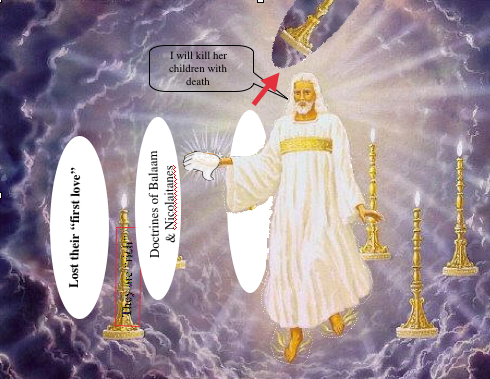
Note that Jesus Himself takes responsibility for the “death” of “her [Jezebel’s] children.” Her “children” are Jesus’ former “servants” whom Gabriel identified as “them that forsake the holy covenant” (Daniel 11:30). And His warning is not just for the church of Thyatira, but for “all the [other] churches” as well.
In the last phrase “according to your works” Jesus gave the responsibility for their plight right back to Jezebel’s children. In other words, they, like Ahab, are without excuse.
Although Jezebel’s philosophy is not called a “doctrine” until the next verse, it seems appropriate to depict Christ’s rejection of this church in the context of this verse. Note that the only church that bears no condemnation, thus far, is the church in Smyrna because they, according to Jesus, are “rich.” They are “rich” in faith and love, which is woefully lacking in the church of Thyatira.
Verse 24: But unto you I say, and unto the rest in Thyatira, as many as have not this doctrine, and which have not known the depths of Satan, as they speak; I will put upon you none other burden.
These are “the loyal believers in Thyatira. Historically, this refers to small groups throughout the Middle Ages that sought to remain loyal to apostolic Christianity” such as “the Waldenses . . .” [44]
The word “rest” is from the Greek “liopay” [45] translated remnant here, and in the following: where a terrified remnant give “glory to the God of heaven” (Revelation 11:13); where a remnant “keep the commandments of God, and have the testimony of Jesus Christ” (Revelation 12:17) and where a “remnant were slain with the sword of him that sat upon the horse” (Revelation 19:21). Obviously, therefore, it is only the remnant who “keep the commandments” that parallel “the rest in Thyatira” who “have not this doctrine” of Jezebel.
Interestingly, the word “known,” from “ginosko” [46] is a “Jewish idiom for sexual intercourse between a man and a woman” which coincides with the metaphoric spiritual adultery represented by those who go to “bed” with “that woman Jezebel.”
The same metaphor, called “Babylon,” representing the admixture of truth and paganism, exists even today. Note Revelation 18:4 where a voice is heard crying “come out of her my people. . .” In spite of being “in” Babylon, they are still God’s “people” who parallel “the rest in Thyatira.” They, in spite of being surrounded with adverse circumstances, are faithful to the light they already have, and Jesus judges them worthy. More light, given prematurely, would be an overwhelming “burden.”
“Notwithstanding the spiritual darkness and alienation from God that exist in the churches which constitute Babylon, the great body of Christ’s true followers are still to be found in their communion . . . Revelation 18 points to the time when . . . the people of God still in Babylon will be called upon to separate from her communion. This message is the last that will ever be given to the world; and it will accomplish its work.” [47]
Verse 25: But that which ye have already hold fast till I come.
While it is not clear the Thyatirans knew the name of Christ, He complimented the church in Pergamos for holding “fast my name” (Verse 13). It seems the Thyatirans didn’t even know that, but what little they did have, they were not to relinquish. Paul said: “For when the Gentiles, which have not the law, do by nature the things contained in the law, these, having not the law, are a law unto themselves” (Romans 2 :14) and therefore, will be judged by what they know. So, these faithful Thyatirans will be judged the same way, because in “the times of this ignorance God winked at” (Acts 17:30).
The last phrase, “till I come,” is a reference to the “’blessed hope, and the glorious appearing of the great God and our Saviour Jesus Christ . . .” (Titus 2:13), giving clear evidence that this message extends to the end of time [48] and is in full force even today, for there are many honest hearted people waiting to hear the unvarnished truth. Jesus said, “other sheep I have, which are not of this fold: them also I must bring, and they shall hear my voice; and there shall be one fold, and one shepherd” (John 10:16).
Verse 26: And he that overcometh, and keepeth my works unto the end, to him will I give power over the nations:
Christ’s “works” are listed as “charity, and service, and faith, and . . . patience” (Verse 19), in contrast to the works of “that woman Jezebel” who taught God’s “servants to commit fornication, and to eat things sacrificed unto idols,” things they were expected to overcome in spite of their ignorance.
The reward for their “charity, service, faith, and . . . patience” was to have “power over the nations,” not in this life, but in the life to come when John “saw thrones, and they sat upon them, and judgment was given unto them . . . and they lived and reigned with Christ a thousand years” (Revelation 20:4).
Verse 27: And he shall rule them with a rod of iron; as the vessels of a potter shall they be broken to shivers: even as I received of my Father.
The second person pronoun “he” and the third person pronoun “them” must refer to the faithful as opposed to the unfaithful “nations” of Thyatirans who, figuratively, went to “bed” with “that woman Jezebel.” The judgment, represented by the “rod of iron,” that was handed over by the “Father” to His son (John 5:22), is, in turn, handed over to the faithful Thyatirans by the Son “even as [He] received of [His] Father.” They will judge the unfaithful Thyatirans and break them “to shivers” which must be figurative language for the “second death” (Verse 11). Of course, they do not preempt God’s judgment that destines the unfaithful to the “second death,” rather, the faithful will fully vindicate the justice of God’s judgment.
Such figurative language suggests that the plight of the faithful Thyatirans was anything but desirable. Evidently, they were unmercifully oppressed and abused. All who find themselves caught in like circumstances should never never give up hope. This is not hope for vengeance, but anticipation that the heavy burden they now are forced to bear will be removed when the power of their oppressors will be broken forever.
Verse 28: And I will give him the morning star.
According to Revelation 22:16, the “bright and morning star” is Christ Himself. He was the “Star out of Jacob,” (Numbers 24:17), and “the daystar” of hope, that, according to Peter, shall “arise in your hearts” (2 Peter 1:19). It is a gift that will never fade or lose its luster. Rather it will grow brighter and brighter until the realization of “the blessed hope, and the glorious appearing of the great God and our Saviour Jesus Christ” (Titus 2:13).
Verse 29: He that hath an ear, let him hear what the Spirit saith unto the churches.
What does Christ’s reprimand to this church for falling into bed with Jezebel and eating “things sacrificed unto idols” mean to us in our day?
Today eastern mysticism is sweeping away many Christians who have become dissatisfied with mainline, mundane Christianity. Such mysticism seems to coincide with the “doctrine” of “that woman Jezebel.” Consider back in the early 1900’s when J. H. Kellog promoted pantheism. In his “. . . book Living Temple there [was] presented the alpha of deadly heresies. The omega will follow, and will be received by those who are not willing to heed the warning God has given.” [49]
Interestingly, “a religion of the New Age, simply put, is pantheism . . .” [50] So, Kellogg’s teaching, although cloaked in another form is still with us. Has it had any effect on churches of our day? Consider the “celebration” form of worship taking many churches by storm? Careful investigation will show a close connection with the New Age movement which bears some elements of the “doctrine” of “that woman “Jezebel.”
Summary of Chapter 2: Chapter 2 covers the basic character and behaviors of the first four of the seven churches in Asia in John’s time. But they are also metaphoric representations of the first four periods of the Christian era from 31 A.D. to somewhere around 1517, the latter part of the Middle Ages. But that is not all, because the messages to all the churches “extend to the end of time.” [4] Of the four churches represented in this chapter, only one, Smyrna, appears to pass muster under the searching eye of our Lord who says, “thou art rich.” While the other three churches all portray favorable characteristics, their flaws appear to negate any saving quality.
———————————————————————————————————————————-
[1] see Seventh-day Adventist Bible Commentary, Vol. 7, page 741
[2] Gospel Workers by E.G. White, page 342
[3] Testimonies for the Church by E.G. White, Vol. 8, page 302 (bracket mine)
[4] Acts of the Apostles by E.G. White, page 585
[5] Manuscript Releases by E.G. White, Vol. 1, page 372 (italics mine)
[6] Seventh-day Adventist Bible Commentary, Vol. 7, pages 742, 743
[7] Ibid page 956
[8] Ibid
[9] Selected Messages by E.G. White, Book 1, page 370
[10] Seventh-day Adventist Bible Commentary, Vol. 7, page 776
[11] Ibid, page 745
[12] but we don’t have to guess much. Believing that the flesh cannot sin, opens the flood gates of sin wide open!
[13] Signs of the Times Feb. 25, 1897 [or Signs of the Times Articles, Vol. 3, page 363 in the combined volumes] (italics mine)
[14] seven verses for Ephesus; six for Pergamos; twelve for Thyatira; six for Sardis; seven for Philadelphia; ten for Laodicea; only four for Smyrna
[15] Seventh-day Adventist Bible Commentary, Vol. 7, page 746 (first paragraph, left upper column)
[16] Ibid under “tribulation”
[17] The Great Controversy by E.G. White, pages 39, 40
[18] Seventh-day Adventist Bible Commentary, Vol. 7, page 746 (right column under “Jews”)
[19] Acts of the Apostles by E.G. White page 585
[20] The Great Controversy by E.G. White, page 608
[21] Seventh-day Adventist Bible Commentary, Vol. 7, page 747 left column, second paragraph
[22] Acts of the Apostles by E.G. White, page 585
[23] Seventh-day Adventist Bible Commentary, Vol. 7, page 747, right column under “ten days.”
[24] Ibid, page 748 (left column)
[25] Remember, these messages “extend to the end of time” (Acts of the Apostles by E.G. White, page 585).
[26] The Great Controversy by E.G. White, page 634
[27] Testimonies for the Church by E.G. White, Vol. 4, page 342
[28] Seventh-day Adventist Bible Commentary, Vol. 7, page 749 left column under “Satan’s seat.”
[29] Acts of the Apostles by E.G. White page 585 (bracket supplied)
[30] from Strong’s #2362 yronov thronos thron’-os; from yraw thrao (to sit), a stately seat (“throne”); TDNT – 3:160,338; KJV – throne 54, seat 7; 61. 1) a throne seat, 1a) a chair of state having a footstool, 1b) assigned in the NT to kings, hence, kingly power or royalty, 1b1) metaph. to God, the governor of the world, 1b2) to the Messiah, Christ, the partner and assistant in the divine administration, 1b2a) hence divine power belonging to Christ, 1b3) to judges i.e. tribunal or bench, 1b4) to elders
[31] Patriarchs and Prophets by E.G. White, page 452
[32] Signs of the Times 12-2-1880 (italics supplied)
[33] Testimonies for the Church, E.G. White, Vol 6, page 150 (italics supplied)
[33a] Ibid, page 163 (italics supplied)
[33b] Patriarch and Prophets by E.G. White, page 297 (italics supplied)
[34] Seventh-day Adventist Bible Commentary, Vol. 7, page 750 left column under “white stone.”
[35] Review and Herald 7-23-95
[36] Seventh-day Adventist Bible Commentary, Vol. 7, page 750 right column
[37] Spiritual of Prophecy by E.G. White, Vol. 1, page 320
[38] Seventh-day Adventist Bible Commentary, Vol. 7, page 751 (left column under “Jezebel.”)
[39] The Great Controversy by E.G. White, page 50
[40] Ibid page 583
[41] Prophets and Kings by E.G. White, page 170
[42] see Seventh-day Adventist Bible Dictionary, page 576, 577
[43] Seventh-day Adventist Bible Commentary, Vol. 2, page 909
[43a] Seventh-day Adventist Bible Commentary, Vol. 7, page 751 (right column under “repented not.)
[44] Ibid, page 752 (left column under “24. The rest.”)
[45] see Strong’s # 3062 l”oipoi loipoy loy-poy’ masculine plural of a derivative of 3007; adv. KJV – other 15, rest 12, others 7, remnant 4, residue 1, which remains 1, other things 1; 41. 1) remaining, the rest, 1a) the rest of any number or class under consideration, 1b) with a certain distinction and contrast, the rest, who are not of a specific class or number, 1c) the rest of the things that remain
[46] see Strong’s #1097 ginwskw ginosko ghin-oce’-ko a prolonged form of a primary verb; TDNT – 1:689,119; v. KJV – know 196, perceive 9, understand 8, misc 10; 223. 1) to learn to know, come to know, get a knowledge of perceive, feel, 1a) to become known, 2) to know, understand, perceive, have knowledge of, 2a) to understand, 2b) to know, 3) Jewish idiom for sexual intercourse between a man and a woman, 4) to become acquainted with, to know. For Synonyms see entry 5825
[47] The Great Controversy by E.G. White, page 390 (italics supplied)
[48] Acts of the Apostles by E.G. White, page 585
[49] Selected Messages by E.G. White, Vol. 1, page 200
[50] En Route to Global Occupation by Gary H. Kath, page 69
